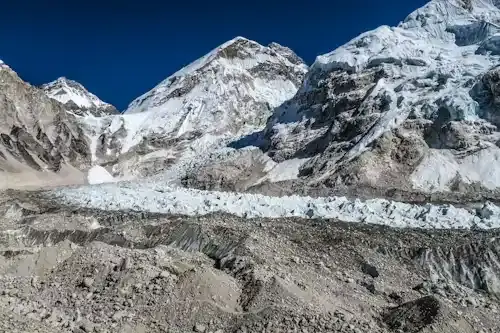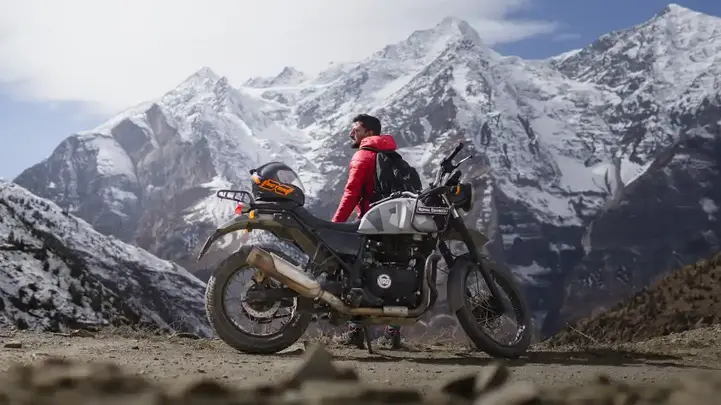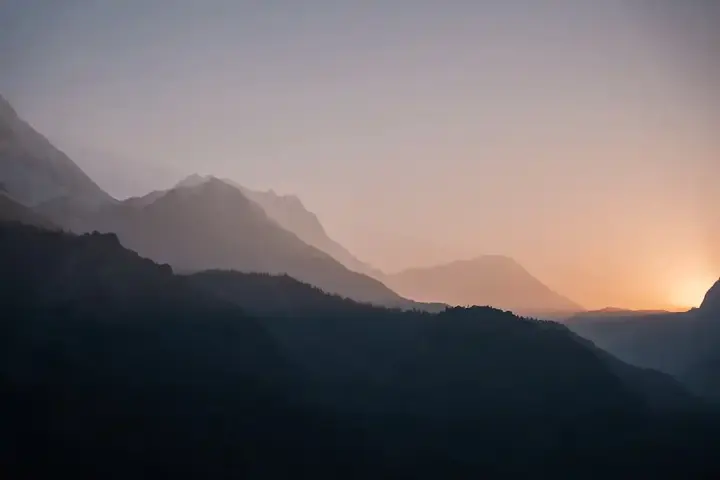There's more to the Himalayas than just epic peaks.
Located in Asia, the Himalayan mountain range began to form about 50 million years ago, when large land masses collided in India and Eurasia due to the movement of tectonic plates. Due to the similar rock density of each land mass, the Earth was pushed upwards resulting in the formation of a winding backbone of towering mountains known as the Himalayas. These mountains stretch for 2,400 kilometers and span five countries – Nepal, China, Pakistan, Bhutan and India – making the Himalayan peaks a stunning destination for trekking and mountaineering.
The highest point on earth

The Sanskrit name Himalaya translates to snow dwelling (Hema) (Alia) and with more than 110 peaks at an altitude of 7,300 meters, it couldn't be more accurate. In fact, 8 of the world's 14 highest peaks of more than 8,000 meters are located in the Himalayan mountain range in Nepal, including the world's highest mountain, Mount Everest. The summit of Everest stands majestically at an altitude of 8848.86 meters, the highest point on Earth, and its height increases every year by 1 cm due to the constant movement of the two land masses. Within the Himalayas, the snow line or permanent snow zone that marks the visible boundary between the snow-covered and snow-free surface is located at an altitude of approximately 5,700 meters. It is located within these high elevations of the Himalayas, in remote areas, where snow leopards, Himalayan musk deer and brown bears can be seen, as well as the Tibetan yak, which is used as a lamb beast in Ladakh. With 3,411 eponymous peaks in the Himalayas, many above the snow line in altitude, everyone who has experienced trekking and mountaineering in this stunning beautiful mountain region will have their favorite ascent.
Recommend
Bhutan - Gangkhar Buensum

There are many unclimbed mountains, sometimes known as virgin peaks in the world. This is usually due to their geographical locations, political instability in the region, or the religious beliefs of the country. Gangkhar Puensum meaning "Three Brothers of the Mountains" holds the title of the highest mountain in Bhutan and the highest unclimbed mountain in the world, with its peak located at an altitude of 7,570 meters. In Bhutan, climbing peaks above 6,000 metres has been banned since 1994 out of respect for spiritual beliefs. Prior to this date, four attempts at the Gangkhar Buensum summit in 1985 and 1986 had failed. Although climbing Jangkar Bonsom is not possible, the Snowman's journey to the remote region of Lunana, considered the most difficult in Bhutan, will allow you to experience the amazing pristine beauty of this country known as the "Land of the Thunder Dragon". After immersing yourself in the culture of Bhutan for 3 days, visiting the National Library which contains ancient books and manuscripts dating back hundreds of years, and the Zurig Shosum Institute which offers a six-year course in 13 traditional arts and crafts to name a few.
India - Kang Yatse II

Kang Yatse (sometimes spelled Kang Yatze) is located at the end of the Marka Valley in the Ladakh region of India. Interestingly, Mount Kang Yatse has two peaks, Kang Yatsi 2, the lower western peak, is 6200 meters high and more easily accessible than Kang Yatsi 1 as artistic mountaineering skills are not necessary in order to reach the summit of this peak. On the other hand, the first Kang Yatsi peak, the 6,400-meter eastern peak, requires a high level of experience and technical skill in mountaineering. Thought by some to be the easiest peaks at 6,000 meters, Kang Yatsi II is a great peak for those hikers who want to gain experience at higher altitudes. And because it's also less crowded than Stok Kangri and others in the area, you can really immerse yourself in the beauty and power of the surrounding environment. Taking a trip to the Marka Valley and the second Kang Yatsi trip is a great way not only to take the second Kang Yatsi summit but also take a trip to the remote and stunning Marka Valley.
Nepal - Everest

On the border between Nepal and Tibet, Mount Everest, also known as Sagarmatha or Chumulungma, is the highest mountain in the Himalayas and in fact stands at 8,848.86 meters. Climbing Mount Everest takes approximately six to nine weeks due to acclimatization at high altitude and low oxygen levels with actual summit windows approximately 7 to 10 days due to weather conditions. The Nepal Mountaineering Association (MNA) classifies "trekking peaks" as those between 5,000 meters and 7,000 meters in height. With Everest's summit rising to more than 8,000 meters, it is classified as mountaineering rather than trekking. If you want to experience Mount Everest without climbing to the summit that requires a very high level of experience, a trip to Mount Everest Base Camp might be perfect for you. A special journey that begins with a flight from Kathmandu to Lukla landing on a steep mountain runway. The journey then begins with a head to the Dudh Koshi Valley via several suspension bridges as you meander into the river and finally enter Sagarmatha National Park. Next is a steep ascent to Namche, a peek at Mount Everest along the way if the weather permits, and only the third day of the trip!

On the fourth day, you will move to the Everest View Hotel at an altitude of 3880 meters and look out at Ama Dablam and Mount Everest. As you continue along the way, you'll enjoy views of the Everest, Lotus, Nobtsy and Amma Dablam mountains. After several descents and ascents, the seventh day ends with a view of the Imja Valley and the stunning southern face of Lotce Island, which is certainly an unforgettable sight. On day eight, you'll ascend steeply towards the foot of the Khombo Glacier and beyond where you'll reach several stone stones, built as memorials to the Sherpa people who lost their lives on Mount Everest. After walking along the glacier, weaving between the ice peaks and past cracks, the journey finally reaches the base camp itself at an altitude of 5,364 meters. The final ascent is the summit of Kala Batatar at 5554 meters for one of the best views of the Himalayas of Everest and the Khumbo Glacier. From here, you'll slowly descend over the next three days before flying from Lukla to Kathmandu on day 13 allowing you time to explore the vibrant city before heading home after this wonderful 15-day journey.








